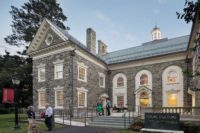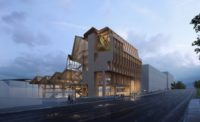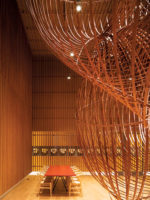Riverside Health Center by 1100 Architect
New York City


















Architects & Firms
Riverside Health Center's next-door neighbor is a 106-year-old Lutheran church, the only building within 32 acres to survive the wrecking ball of notorious New York planner Robert Moses as part of a huge slum-clearance project in the 1950s. The health center, on the other hand, sprang up in the early 1960s in the demolished Upper West Side neighborhood once known as Manhattantown. It was a low beacon among the new high-rise housing developments. Designed by Harry M. Prince, Architect, the H-shaped, three-story brick and terra-cotta structure, which comprises a library within its east wing, was one of many public amenities designated for the revitalized neighborhood; just across the street, a similarly set-back '60s-era building contains a police precinct headquarters and firehouse.
Additional Content:
Jump to credits & specifications
Riverside dutifully served the community—which remained mainly low-income—for over 40 years, but by the start of the new century was in need of a revitalization of its own. The New York City Department of Health and Mental Hygiene selected 1100 Architect through the Department of Design and Construction's Design Excellence program to modernize the deteriorating 36,000-square-foot facility.
While the New York– and Frankfurt-based firm had completed numerous renovation projects, this was its first health-care facility. The program here was unique as well, taking into account the needs of various entities including the Nurse Family Partnership, a nurse-led maternal health and home visitation program for first-time mothers; the NYC Health Academy, which provides training in food safety where certification is required; and a clinic for sexually transmitted diseases.
1100 did away with the old layouts to accommodate the new and returning tenants' expanding needs and to simplify circulation. While a second elevator was installed, so was a second stairway, and its use is encouraged through signs bearing aphorisms—“When you go up, your blood pressure goes down,” for instance. A handsome windowed area in the rear portion of the second level, with low office furniture, permits views of trees and the historic church. The enlarged cellar—crawl space was excavated with light wells for additional offices and storage—includes an employee fitness room, and a community room variously used as an emergency command center for the Department of Health, or for breastfeeding seminars and similar lectures and gatherings.
The reception area and hallways feature resurfaced terrazzo, while floors in offices, exam areas, and classrooms are covered in end-grain wood tiles. Finishes are bright and cheery. “We selected durable but playful materials,” says 1100 principal in charge Juergen Riehm. In particular, colorful tiles in staircases and along select walls complement the bright orange exterior terra-cotta on the stair tower near the entrance. (The late artist Richard Artschwager, who was engaged through New York's Department of Cultural Affairs' Percent for Art Program before 1100 began, selected the cladding.) “We were happy to design around the new terra-cotta,” says Riehm. The rest of the facade was also spruced up—brick was replaced and repointed as needed, and exterior lighting and stainless-steel railings installed.
Sustainable design strategies were incorporated to meet the city's requirement that the new facility be certified LEED Silver, at minimum. It is on track to exceed that. Double-hung windows were replaced with tilt-turn ones. Daylighting and efficient LED and fluorescent fixtures, some controlled by occupancy sensors, provide illumination. An upper-level addition includes a green roof and brise-soleil to control solar gain inside the new space's classrooms.
For New York, a revamped Riverside represents a continued commitment to communities in need. For 1100 Architect, which recently began working with the NYC Parks Department on recreation centers in Brooklyn and the Bronx, the facility represents a turning point in the firm's focus. Says Riehm, “It is part of our longer-term vision to do more projects that affect larger groups of people.”
CreditsClient: NYC Department of Design & Construction and NYC Department of Health and Mental Hygiene
Owner: NYC Department of Health and Mental Hygiene
Architect: 1100 Architect Personnel in architect's firm who should receive special credit:
Architect of record: 1100 Architect
Interior designer: 1100 Architect
Engineers: Structural Engineer: Silman M/E/P Engineer: Buro Happold Engineering Civil Engineer: Matrix New World Engineering
Consultant(s): Landscape: Quennell Rothschild & Partners Lighting: Atelier Ten A/V Consultant: Shen Milsom & Wilke, Inc. Sustainability Consultant: Atelier Ten Kitchen Consultant: KDS Consulting & Design, Inc. Exterior Consultant: James R. Gainfort, AIA Consulting Architects PC Artist: Richard Artschwager Health Care Consultant: Perkins Eastman
Photographer(s): Nikolas Koenig (415) 845-6919
Size: 36,000 square feet
Construction cost: $28 million
Project cost: withheld
Completion date: December 2014 |
SpecificationsStructural system Exterior cladding Rainscreen: Boston Valley Terra Cotta - TerraClad Moisture Barrier: Vapor Permeable Air barrier: Henry Company Airbloc Other cladding unique to this project:Cast Stone Coping: Continental Cast Stone Coping Roofing Other: Green Roof: Siplast/Zinco USA Windows Glazing Doors Metal doors: LIF Industries Wood doors: Bamboo/ Algoma Hardwoods, Inc Fire-control doors, security grilles:SAFTI FIRST Fire Rated Glazing Solutions Hardware Closers: LCN Exit devices: Von Duprin Pulls: Sugatsune Interior finishes Cabinetwork and custom woodwork:Bamboo reception desk Paints and stains: Sherwin Williams Wall coverings: Polyflor Plastic laminate: Pionite Solid surfacing: Dupont Corian, Dupont Zodiaq Special surfacing: Epoxy Terrazzo: Terroxy TM Supply Floor and wall tile: Ceramic Wall Tile at Stairs/Hallways/Bathrooms:Wizard Enterprise Resilient flooring: Lonseal Raised flooring: Endgrain Wood Flooring: Oregon Lumber Special interior finishes unique to this project: Wood Ceiling: Rulon International Furnishings Reception furniture: Herman Miller Chairs: Herman Miller Tables: Coalesse Lighting Downlights: Edison Price, Wila Lighting Task lighting: Alko Exterior: Bega Conveyance Accessibility provision: Lift: Garaventa Lift Plumbing Energy Other unique products that contribute to sustainability: |

















